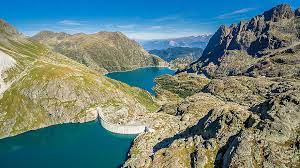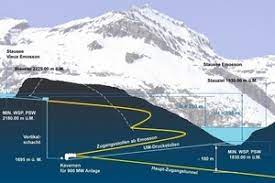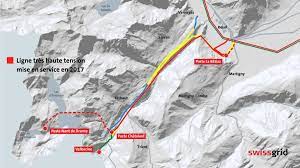
Ελβετία: υπόγειος σταθμός παραγωγής – αποθήκευσης ενέργειας με νερό (αντλιοταμίευση) για 20 εκατομ κWh
Μετά από 14 χρόνια εργασίας και εντατικών δοκιμών, η μονάδα παραγωγής και αποθήκευσης ηλεκτρικής ενέργειας Nant de Drance στο ελβετικό καντόνι Valais τέθηκε σε λειτουργία την 1η Ιουλίου 2022. Με ικανότητα παραγωγής και αποθήκευσης ισχύος 900 MW, η μονάδα παραγωγής ενέργειας Nant de Drance στοχεύει να διαδραματίσει βασικό ρόλο στη σταθεροποίηση των ελβετικών και ευρωπαϊκών δικτύων ηλεκτρικής ενέργειας και να συμβάλει στην ασφάλεια του εφοδιασμού με ηλεκτρική ενέργεια στην Ελβετία.

Το εργοστάσιο παραγωγής και αποθήκευσης ενέργειας βρίσκεται στις Ελβετικές Άλπεις στον δήμο Valais του Finhaut μεταξύ Martigny (CH) και Chamonix (F). Ο σταθμός είναι εντελώς υπόγειος, με μόνο τις δεξαμενές Emosson και Vieux Emosson ορατές απέξω. Οι εργάτες χρειάστηκε να ανοίξουν σήραγγα μέσα 11 μίλια των ελβετικών Άλπεων. Περισσότεροι από 400 εργάτες, εργάστηκαν περίπου 10 χρόνια στις υπόγειες κατασκευαστικές εργασίες στα ψηλά βουνά, για 17 km τούνελ και 1,7 εκατομμύρια m³ ανασκαμμένου βράχου.

Η μονάδα λειτουργεί ως μια “μπαταρία” (αντλιοταμιευτήρας) που αποτελείται από δύο μεγάλα σώματα νερού σε διαφορετικά ύψη και κανάλια που βρίσκονται σχεδόν 2.000 πόδια κάτω από το έδαφος μεταξύ των φραγμάτων Emosson και Vieux Emosson στο καντόνι Valais.
Η περίσσεια ενέργειας μπορεί να χρησιμοποιηθεί για την άντληση νερού από την κάτω λεκάνη προς την υψηλότερη. Όταν η ζήτηση ενέργειας αυξάνεται, το νερό στην υψηλότερη λεκάνη αφήνεται να ρέει πίσω στην κάτω δεξαμενή αλλά καθώς το νερό ρέει, περιστρέφει τις τουρμπίνες που παράγουν υδροηλεκτρική ενέργεια.
Το έργο διαχειρίζεται η Nant de Drance SA και παρακολουθείται από μια συμβουλευτική ομάδα που εκπροσωπείται από την WWF, την Pro Natura, τις ενδιαφερόμενες δημόσιες αρχές, το καντόνι του Valais καθώς και την Ελβετική Ομοσπονδιακή Γραφείο Ενέργειας
Μία από τις προτεραιότητες της Nant de Drance και των αρχών αδειοδότησης είναι η μείωση των περιβαλλοντικών επιπτώσεων όσο το δυνατόν περισσότερο. Δεκαπέντε έργα συνολικού κόστους είκοσι δύο εκατομμυρίων ελβετικών φράγκων έχουν ολοκληρωθεί ή θα ολοκληρωθούν σύντομα για να αντισταθμίσουν τις περιβαλλοντικές επιπτώσεις από την μονάδα παραγωγής και τη γραμμή πολύ υψηλής τάσης (αναλυτικά στο αγγλικό κείμενο που ακολουθεί).
Η Nant de Drance SA και οι μέτοχοι της Alpiq, SFR, IWB και FMV θα εγκαινιάσουν επίσημα τον σταθμό ηλεκτροπαραγωγής τον Σεπτέμβριο. Το ευρύ κοινό θα έχει την ευκαιρία να εξερευνήσει το εργοστάσιο κατά τη διάρκεια εκδηλώσεων το Σάββατο 10 και την Κυριακή 11 Σεπτεμβρίου 2022.
——————————————————————————————————————————————————————————————
Swiss pumped storage power plant ” with 20 million kWh of capacity functional
Swiss “water battery” with 20 million kWh of capacity is finally functional. The project took 14 years to complete. The Nant de Drance pumped storage power plant is located in the Swiss Alps in the Valais municipality of Finhaut between Martigny (CH) and Chamonix (F). The power station is completely underground, with only the Emosson and Vieux Emosson reservoirs visible from the outside. Workers had to tunnel through more than 11 miles of the Swiss Alps. More than 400 workers, around 10 years of underground construction work in the high mountains, 17 km of tunnels and 1.7 million m³ of excavated rock . The Swiss Nant de Drance construction site is gigantic.
The project is comprised of two large bodies of water at different heights – in this instance, they are located nearly 2,000 feet below ground between the Emosson and Vieux Emosson dams in Valais. Excess energy can be used to pump water from the lower basin to the higher one. When power demand increases, water in the higher pool flows back into the lower reservoir. As the water flows, it spins turbines which generate hydroelectric power. The facility was constructed by Nant de Drance and is capable of storing 20 million kWh of electricity, which should help stabilize Switzerland’s energy grid.
The Nant de Drance power plant has a capacity of 900 MW, making it one of the most powerful pumped storage plants in Europe. It is located 600 meters underground, between the Emosson and Vieux Emosson reservoirs, and has a storage capacity of 20 million kWh. The plant offers flexible power generation, playing a key role in stabilising the electricity grid throughout Europe and in safeguarding Switzerland’s power supply.
Nant de Drance SA is a corporation with a share capital of CHF 350 million held by the following four shareholders: Alpiq (39%), SBB/CFF (36%), IWB (15%) and FMV (10%). The main activity of the Nant de Drance SA is the pumping and turbining of hydropower between the Vieux Emosson and Emosson reservoirs, including in particular the construction and operation of the associated facilities.. The headquarters are located in Finhaut, Switzerland.Protecting the environment
One of the priorities of Nant de Drance and the licensing authorities is to reduce environmental impact as much as possible. Fifteen projects at a total cost of twenty-two million Swiss francs have been, or will soon be, completed to offset the environmental impact of the following constructions: pumped storage power plant and very high-voltage line connecting the power plant to the power grid.
The work is managed by Nant de Drance SA and monitored by an advisory group represented by WWF, Pro Natura, the public authorities concerned, the canton of Valais as well as the Swiss Federal Office of Energy.
Compensation measures
Most measures aim to recreate specific biotopes locally, especially wetlands, in order to encourage recolonisation of the area by certain rare or endangered animal and plant species in Switzerland.
- Four measurements are being carried out on the site perimeter. They concern four areas – located in Châtelard, in Bierle (municipality of Trient), at the Gueulaz pass and at the foot of the Vieux-Emosson dam – used in particular to store the excavated material from the tunnels and caverns. Nant de Drance is rehabilitating these areas and creating environments that encourage biodiversity. It is also planned to create an educational trail in Châtelard.
- The Salanfe SA’s overhead power line, located between the Miéville plant and Salanfe, has been installed below grade because it was dangerous for birds.
- In Salvan, pastures have been reopened following brush-clearing work. Wet biotopes will also be created. This measure is carried out in collaboration with farmers and breeders from the region and enables to support mountain agriculture.
- The wetland of the Fond du Mont in Vernayaz, which had been drained, has been refilled with water, in collaboration with the municipality. As part of this project, the Lantze Canal will undergo renaturation, and downstream, in Miéville, small lakes will be created along the River Salanfe.
- In Vernayaz, the bed of the Trient River will be widened by relocating the existing dyke between the SBB bridge and the motorway bridge in order to create an alluvial zone and give more space to the river. Additionally, specific biotopes will be developed set back from the bed of the River Trient.
- In the municipality of Dorénaz, work is being carried out as part of a project to secure the stream in Alesse and a wetland has been developed along the right bank of the Rhône.
- From the mouth of the Trient to the Dorénaz bridge, the bed of the Rhône will be widened to give it more room to expand, particularly in the event of flooding. Considered a priority, this measure is being carried out during the 3rd Rhône correction with the financial participation of Nant de Drance SA.
- Going up the Rhône in the direction of Martigny, the so-called “Lac des Sables” measure will consist of reclaiming a gravel quarry lake and creating wetlands.
- In the municipality of Martigny, biotopes have been developed in the forest along the Bienvenue Canal in order to increase the amphibian population, or more specifically, yellow-bellied toads.
- In Saxon, as part of a project to secure the municipality’s canals, Nant de Drance SA has completed the widening and regeneration of these canals in order to promote biodiversity.
- Nant de Drance, in collaboration with WWF, is managing an on-going project to eliminate invasive plants, such as Japanese knotweed, which have colonised the banks of the Trient.

Αφήστε μια απάντηση